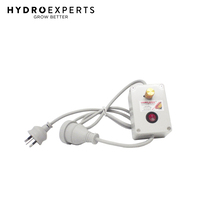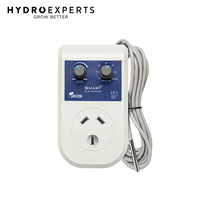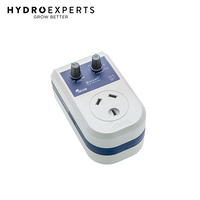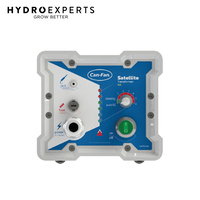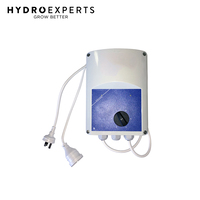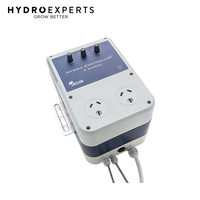How to Choose the Best Fan Controller for Your Fan?
By One Stop Grow Shop | 2 January 2020
Adding a fan speed controller to your extraction system provides the user with the ability to adjust how fast the fan is running and therefore the extraction rate. This is especially handy as the weather becomes cooler. A large extraction system running at full tilt may be great at keeping temperatures right during the height of summer. However in many cases, when the cooler months arrive, the same large extraction system without any controller will make it virtually impossible to keep temperatures warm enough for good plant growth.
Different Types of Fan Speed Controllers:
Once you have made the decision to purchase a fan speed controller and you begin to search around for one, it tends to become apparent that there are different types or “breeds” of the controller. The first type of controller is generally smallish, lightweight and economically priced. The second type is much larger, quite heavy and costs a noticeable amount more. So, what is the actual difference between these types? What advantages does the larger, heavier and more expensive type give? The different types of controller actually use different methods to control the fan speed.
1) Circuit-board type Fan Speed Controllers - View Products
First of all, let us take a look at the smaller, lighter and (usually) cheaper of the two types:
These types of fan speed controller work on the principle of switching the mains voltage to your fan on and off very quickly, usually many times per second. Each on-off period is called a “cycle”. The way that the speed is controlled is by adjusting the amount of time that the mains voltage is on for compared to the length of time of that it is off for during each cycle.
Let’s say that Fan Speed Controller “A” switches the mains voltage to the fan on and off 10 times per second. This means that the cycle time is 1/10 of a second, or 100 milliseconds (ms). When the fan speed is set to maximum, the mains may be switched on for the whole cycle or the whole 100ms. When the controller is set to half speed, the mains voltage will be sent to the fan for 50% of the time (i.e. 50ms) and switched off for 50% of the time (also 50ms). When the controller is set to 30%, the mains voltage will be sent to the fan for 30% of each cycle (30ms) and then switched off for 70% of each cycle (70ms).
This system of “pulsing” the power to the fan can cause a slight problem as the pulsing can be heard in the sound of the motor. Motors have a sound of their own which is usually a fairly constant hum in nature. Adding a circuit-board type of controller can add a noticeable resonance (most usually a “beat” or “throb” or extra “hum”) to the motor sound. Depending on the fan’s location, this may be very undesirable. If a resonance coming from the fan is not a problem then a cheaper circuit board type controller will be adequate.
One great advantage of the circuit-board type fan speed controllers is that because they use electronic control, they often come with a means of controlling the fan speed thermostatically or by temperature control. You place the attached temperature sensor in the appropriate place near your plants, dial in the desired temperature on the front of the box and the controller will alter the fan’s speed to keep the area at the temperature that is set.
Many circuit-board types can also control an extraction fan AND an in-take fan, adjusting the speed of both automatically via the temperature control. The inlet fan will run slower than the extraction fan in order to maintain negative air pressure.
2) Variac style Fan Speed Controllers
These beasts use a totally different methodology to adjust the fan speed. Basically, they consist of a large, adjustable, electrical transformer in a box with a control on the front. Unlike the circuit-board type controller which works by switches mains electricity on and off quickly, Variac style fan speed controllers work by reducing the constantly-fed mains voltage to the fan.
There is no pulsing of electricity with these types of controller. Hence there is no resonance from the fan. However, this type of controller does not have automatic temperature control. Fan speed must be adjusted manually by the user, using the control. There are not normally 2 separate outputs to control an extraction fan and an inlet fan. However, as long as the controller is rated at a high enough current, 2 fans can be attached to the output. Negative air pressure can still be maintained by using a smaller inlet fan than the extraction fan.
As already mentioned, Variac style controllers are basically adjustable electrical transformers. These consist of large numbers of intertwined turns of wire mounted on an iron core. This means they are much heavier than their circuit-board type counterparts.
3) Hybrid Fan Speed Controllers - View Products
Combining the best of both worlds we have the Hybrid Fan Speed Controller. These adjust the speed of the fan with a variable transformer like the Variac style controller. However, the variac is controlled with an electronic circuit board. This means that there is no fan resonance and there is a wonderful facility of automatic temperature control. The only down-point about these is that they are heavy and more expensive but for those who insist on the best, they are definitely the way to go!




